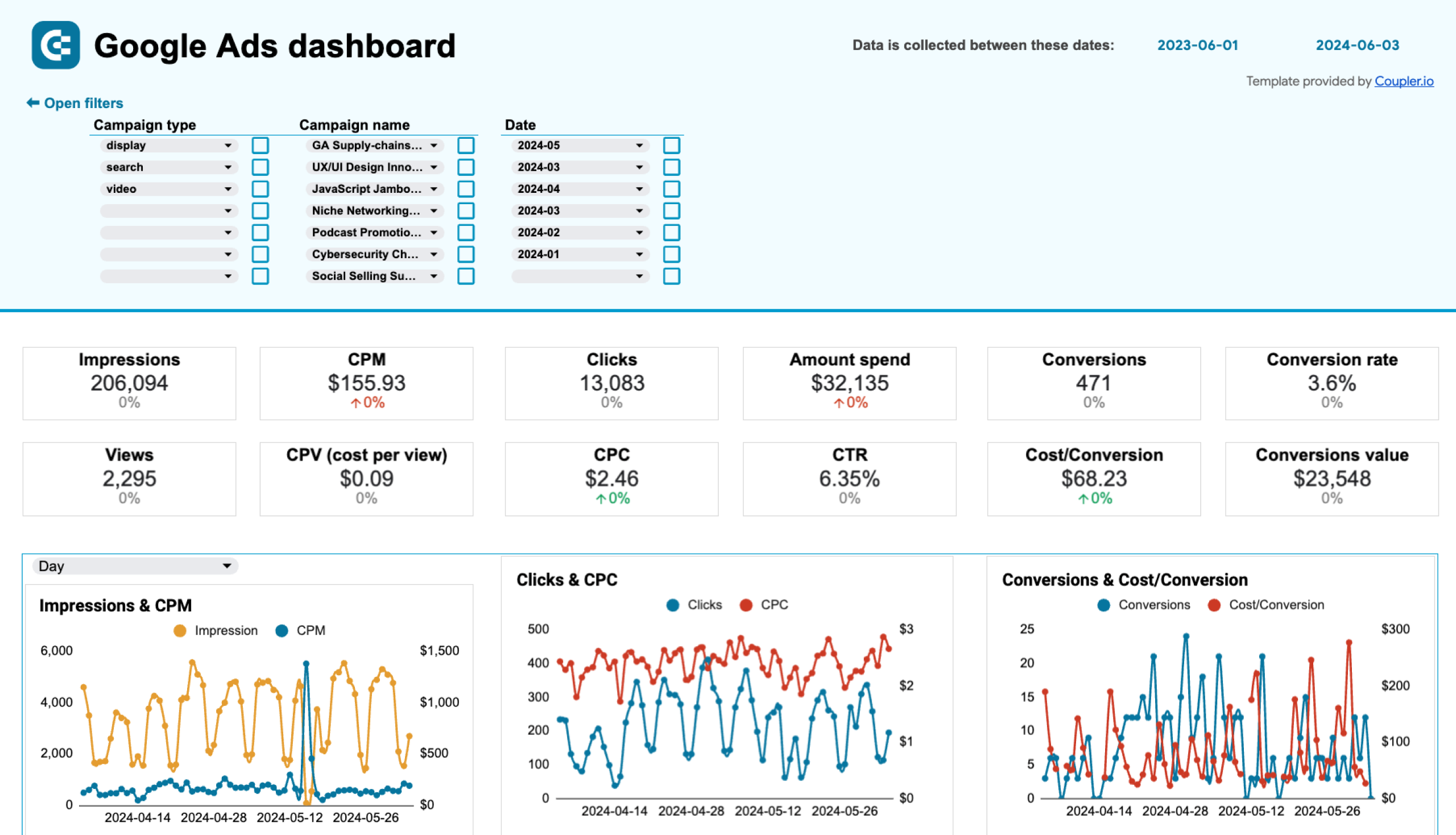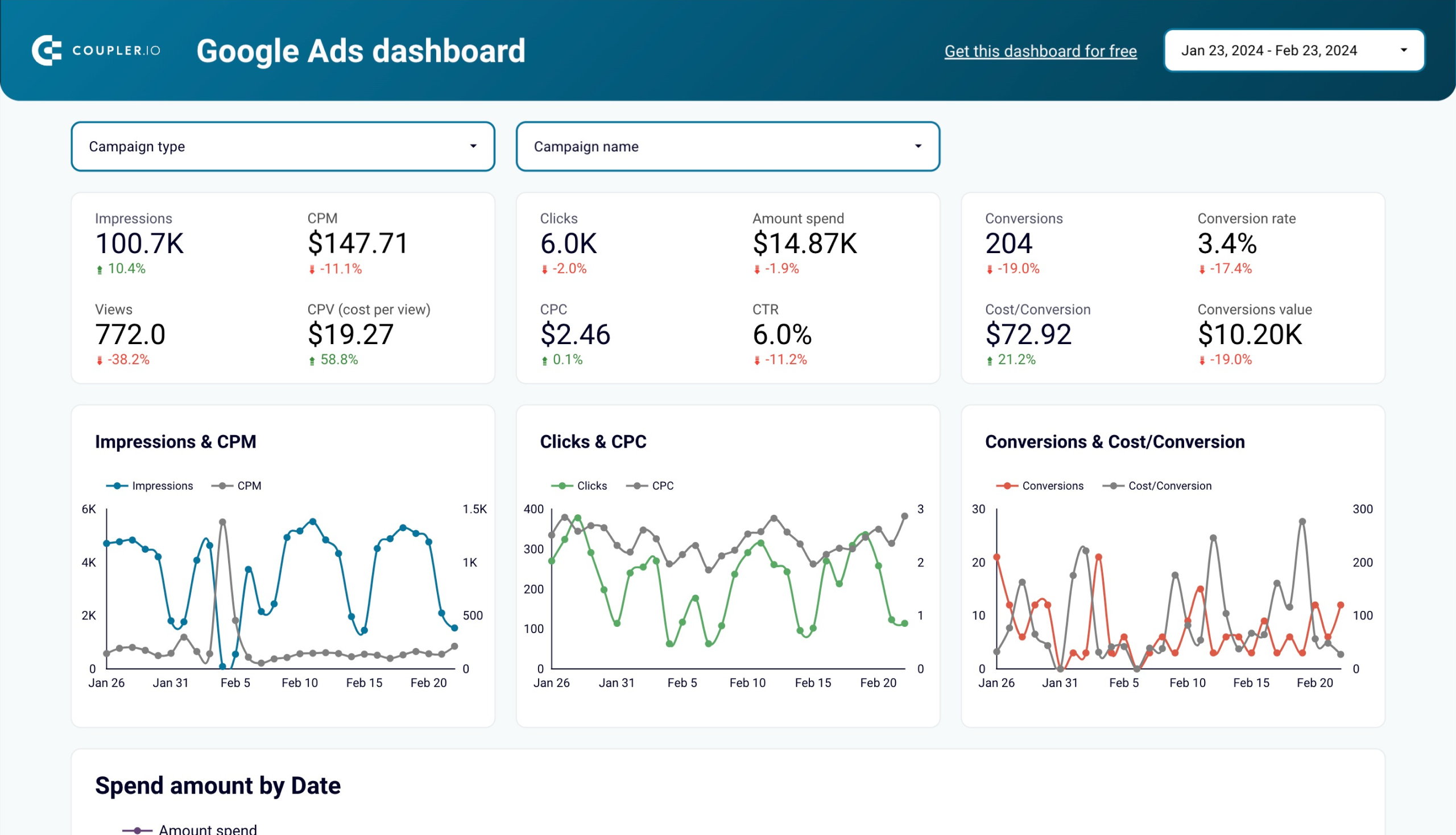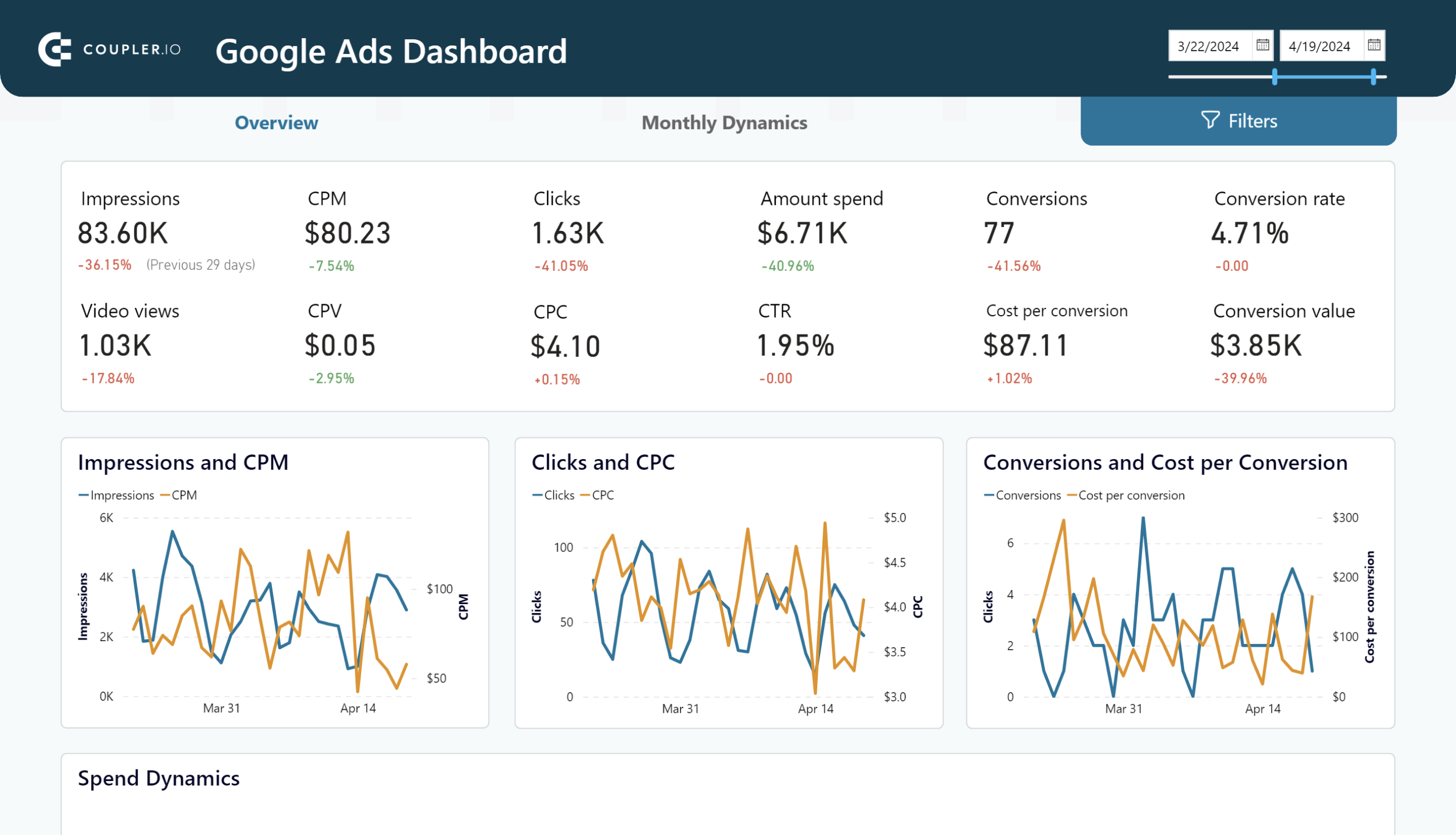Why do you need to optimize Google Ads?
You can probably do without optimizing Google Ads, but only if you have plenty of budget funds to spare and don’t care about return on investment and cost per acquisition.
Very few businesses fall into that category, though, so the odds are that Google Ads optimization is on your bucket list. But even if you do have a budget to spare, wouldn’t it be great to produce the same results with PPC but for much less money? This is where Google Ads optimization comes in.
Analyzing your ad campaigns and optimizing them helps improve two major factors every campaign is based on: overall cost and number of conversions.
There are multiple ways to optimize a Google Ads campaign, from picking the right keywords to reach your desired audience to adjusting bidding to spend less money on the same number of leads.
You have probably seen the optimization score metric in your Google Ads account? It’s a neat score calculated by Google that should reflect how effective your campaigns are and show suggestions for improvements.
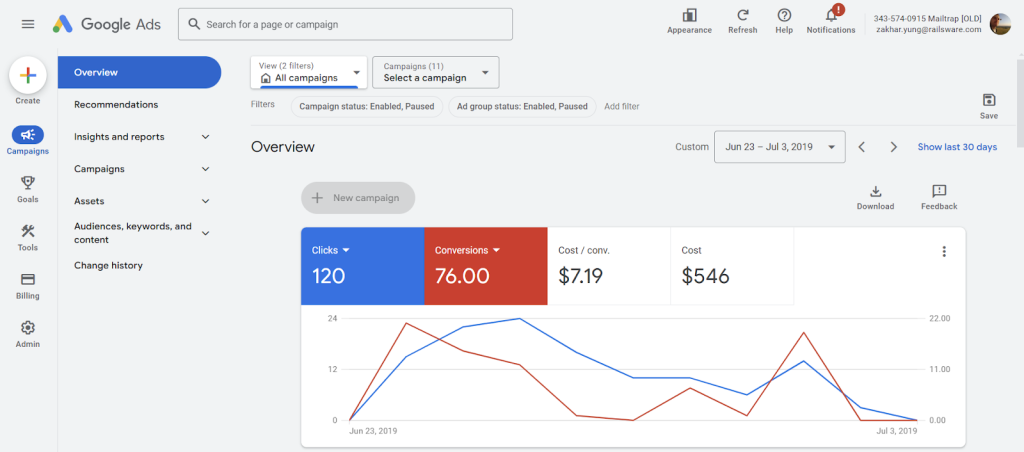
It does provide interesting ideas you could try, but reaching 100% doesn’t guarantee the effectiveness of your campaigns. This score is only an estimate of how well your campaign can perform based on the settings, not a measure of how well it actually performs.
That’s why Google Ads optimization involves much more than maximizing the optimization score.
Let’s see what steps you can take to optimize Google Ads.
Google Ads optimization checklist
If you want to optimize Google Ads, you need to launch a continuous process full of experiments and involving regular adjustments. The goal of this process is to keep the balance between the cost of your campaigns and the number of leads you receive.
This handy checklist will help you optimize Google Ads and enhance performance while keeping the budget in check.
- Optimize ads keywords
- Update ad group structure and account structure
- Optimize Google Ads headlines and copy
- Conduct bid optimization in Google Ads
- Implement Google Ads campaign optimization
- Check and update your landing page
Optimize ads keywords
- The quality score for your keywords is between 7 and 10
- Keywords with lower scores are paused
- Underperforming keywords are identified and paused
- Irrelevant seasonal keywords are paused
- The list of keywords is expanded with new keywords
- Keywords with high CTR but poor engagement are added to the negative keyword list
- Competitors’ keywords are analyzed for insights and fresh ideas
- Different keyword match types are used (broad match/exact match)
- Long-tail keywords are included in the mix
- Single keyword ad groups (SKAGs) are a part of the mix
Update ad group structure and account structure
- The ad group structure is aligned with the current proposition
- The number of keywords per ad group is limited to 15-20 per group
- Each ad group only contains highly relevant keywords
- The account structure is clear and logical
Optimize Google Ads headlines and copy
- The headline
- includes a target keyword or a variation of it
- appeals to emotion or intrigues interest
- is clear and understandable
- reflects the landing page content
- Site links reflect the pages they lead to
- The copy
- includes a call to action
- doesn’t have grammar mistakes
- reflects the search intent
- with high CTR but low conversion is adjusted to reflect search intent
- describes your services clearly
- covers a customer pain point
Conduct bid optimization in Google Ads
- The monthly and daily spending limits are set correctly
- The correct goal is set for each bid
- Highly converting ads are given priority for sales goals
- CPM bidding is given priority for brand awareness goals
- Bid adjustments are set up for high-CTR, high-converting copy
- Automatic bid decrease set up for low-CTR or low-traffic copy
Implement Google Ads campaign optimization
- Multiple types of conversion trackings are set up
- Ad performance data is constantly monitored
- Historical data analytics is used to find the best-performing targeting factors
- Bid adjustments support best-performing ads
- Historical data analytics is used to find search terms
- Ads that can be highly targeted are served on a phrase or exact-match basis
- Individual ads are tailored to the search intent and target audience
- A/B testing is set up to create a better-converting copy
- The day and time for displaying your ads are relevant to your product and audience
Check and update your landing page
- The page loads immediately, without delay
- Visual elements are displayed correctly
- The landing page looks and works well both on desktop and mobile
- The content matches the keywords from the ad
- Your offer is communicated clearly above the fold
- CTA button is displayed above the fold
- The contact form is tested and works with no issues
- Conversion tracking is set up for all converting actions
Google Ads optimization tips
The checklist above allows you to quickly check that you don’t forget to implement all optimization best practices in your campaign. But if you want to implement them effectively, you’ll need to learn specific optimization tactics.
You’ll pick up more and more tactics that work for your company, specifically as you progress through the Google Ads learning curve. It’s always good to have a starting point, though. Here are the best practices that can work well with any business.
1. Analyze performance in-depth
The most important thing you can do to optimize your Google Ads campaign is to analyze its performance data. Without this important step, you can’t know what areas of a campaign you should focus on.
The first step towards reliably analyzing ad campaign performance is setting up conversion tracking. Some campaigns lack multiple conversion tracking capabilities, and you end up not seeing the full picture.
You can add tracking of multiple user actions, not only making a purchase directly after clicking on the ad. Google Ads account allows you to create up to 15 trackable user actions, such as signing up for the newsletter, downloading an eBook, or leaving their contact information.
Once you set up conversion tracking and run your ad campaigns for a sufficient time, you have to make sense of all that data. You can do this using the following approaches:
- Built-in analytics: Google Ads’ native features allow you to create and schedule reports on campaign performance, either from scratch or using built-in templates. While this method is straightforward, its limited customization options may only partially meet your advanced analytics needs.
- Custom report creation: By creating custom reports from scratch, you can tailor analytics to your specific requirements. Coupler.io, for example, lets you build reports on the go and load them into the preferred app for data visualization, including spreadsheets and BI tools.
Learn how you can import data from Google Ads to Excel and from Google Ads to Google Sheets.
- White-label dashboard templates: If you want to turn Google Ads data into actionable insights without building reports from scratch, use ready-made dashboard templates. For instance, Coupler.io provides free templates for Google Sheets, Looker Studio, Power BI, and Tableau.
Now, let’s take a closer look at this last approach.
2. Use Google Ads performance dashboards
Coupler.io’s Google Ads dashboards let you monitor campaigns’ performance in one place, with automatic updates on your chosen schedule. This gives you quick access to near real-time data, serving as a foundation for informed decisions on ad optimization.
For example, this Google Ads dashboard offers a detailed view of crucial digital advertising metrics and trends.
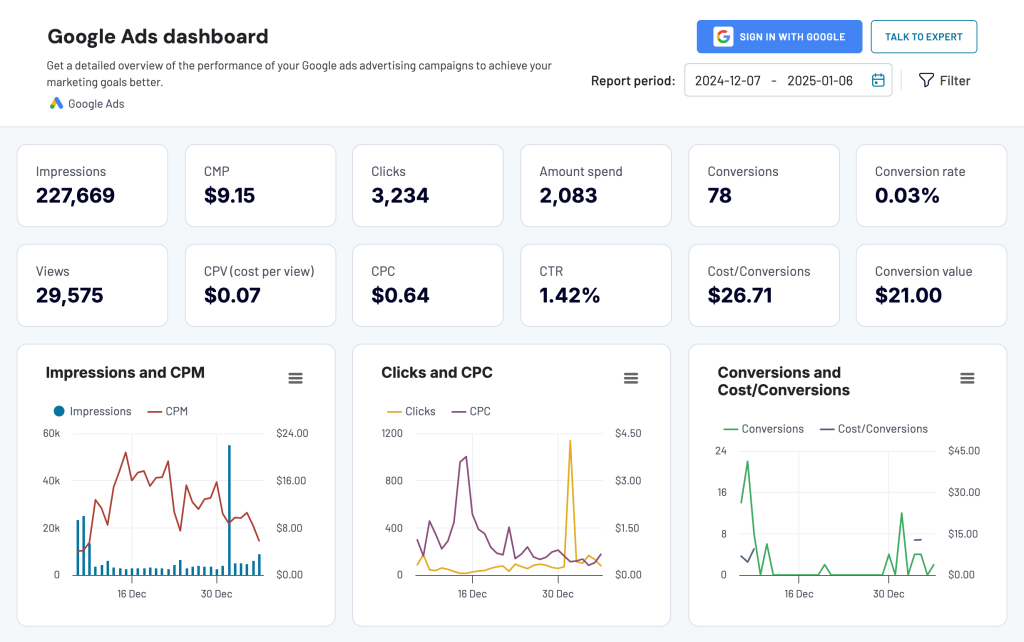
You can easily connect the dashboard to your Google Ads account and get your performance data in a matter of minutes. Moreover, the dashboard is free, so preview and try it your data right away.
For reporting in external BI tools like Looker Studio or Power BI, Coupler.io offers this dashboard as a template. Whichever option you opt for, you’ll be able to:
- Compare the current values of each metric to the selected period to gain a quick insight into the progress of your campaigns.

- View the funnel based on all the conversions you’ve set up for your Google Ads campaigns.
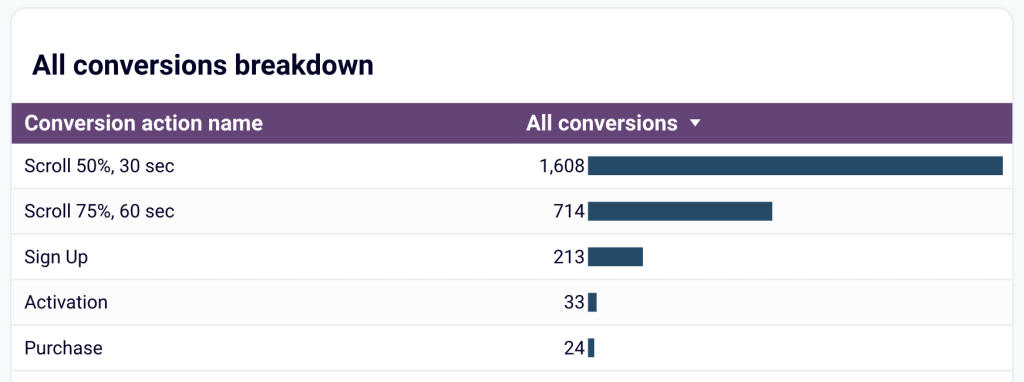
- Additionally, the dashboard allows you to view performance data from a timeline perspective. You can quickly filter the aggregated data by period, among other criteria.
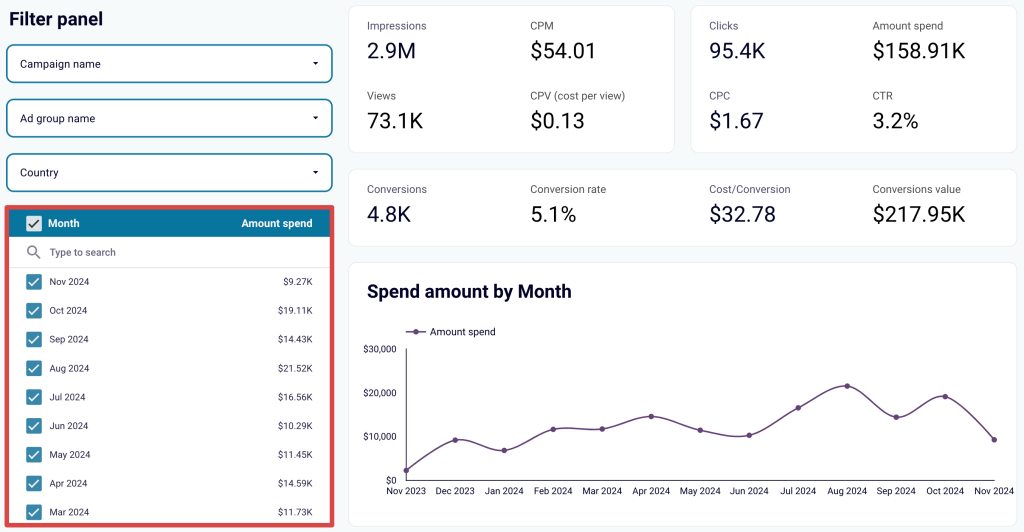
Access this and more of Coupler.io’s self-updating dashboard templates to gain better control over your Google Ads performance and measure ad creative effectiveness. The Google Ads dashboard is available in three versions: Google Sheets, Looker Studio, and Power BI.
3. Pick the right keywords
One of the most important things you can optimize in your ad campaign is the keywords you’re targeting. Start with discovering what keywords bring you the most leads and the best ROI. Limiting spending on the worst-performing keywords and focusing on the best-performing ones is a quick optimization fix.
Going deeper into search term reports can help improve your list of keywords. Check what search terms convert the least and consider adding them to the negative keyword list.
Among those that convert best may be search terms you don’t intend to show ads on – users could be seeing your ads thanks to Google displaying them on a different search term. If you see keywords you haven’t targeted yet, you could try including them in the list and tailoring the message closer to that search intent.
While most campaigns start with exact or phrase-match keywords, it’s always a good idea to expand into a broad match to find new keyword opportunities. Finding keywords that convert well allows you to focus more resources on them and tailor the ad copy to increase conversions.
To track the effectiveness of your keywords, use Coupler.io’s Google Ads keyword performance dashboard template in Looker Studio. It helps you identify the highest- and lowest-performing keywords or keyword groups and adjust your strategy accordingly.
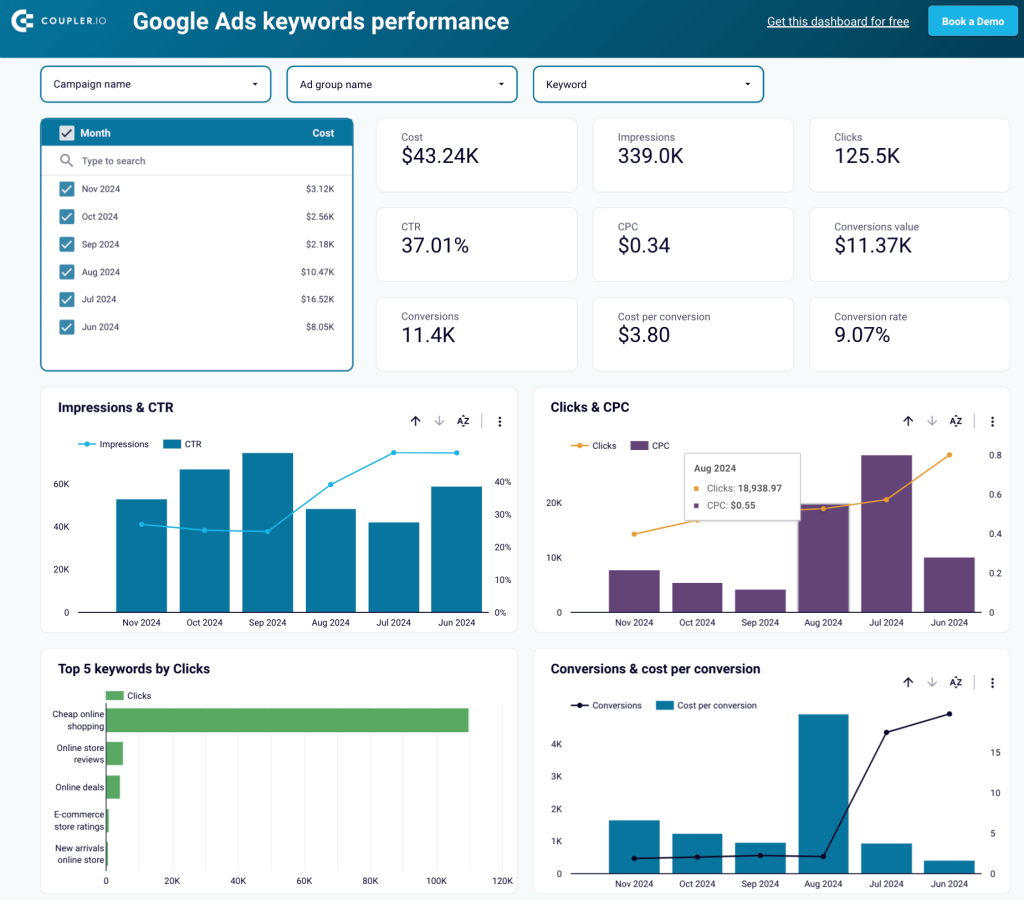
Use this dashboard to analyze keywords by campaign or ad group, track performance over time for specific keywords, and spot keywords that underperform in search impressions.
4. Research your competitors
There are multiple ways of getting inspiration to optimize your paid ad campaigns. One of them is spying on your competitors.
With a keyword research tool, you can gather keywords on which your competition is running ads. Granted, it can’t give you access to their Google Ads panel, but these tools quite accurately estimate where their ads show.
This can be a great way to discover new keywords to add to your campaign.
For more details, check our guide on PPC competitor analysis.
5. Know your target demographics
One way to curate what kind of audience sees your ads is by niching down on your keywords. Another is choosing the right demographic.
Most businesses have a general idea of their target audience and set up campaigns to compel their specific demographics into buying. It’s always a good idea to tailor a campaign’s demographic targeting based on actual performance data instead of your assumptions.
Run a report on what types of demographics convert best on different campaigns and consider targeting them specifically. Consider doing this with Coupler.io’s Google Ads dashboard template in Looker Studio, which we mentioned earlier.
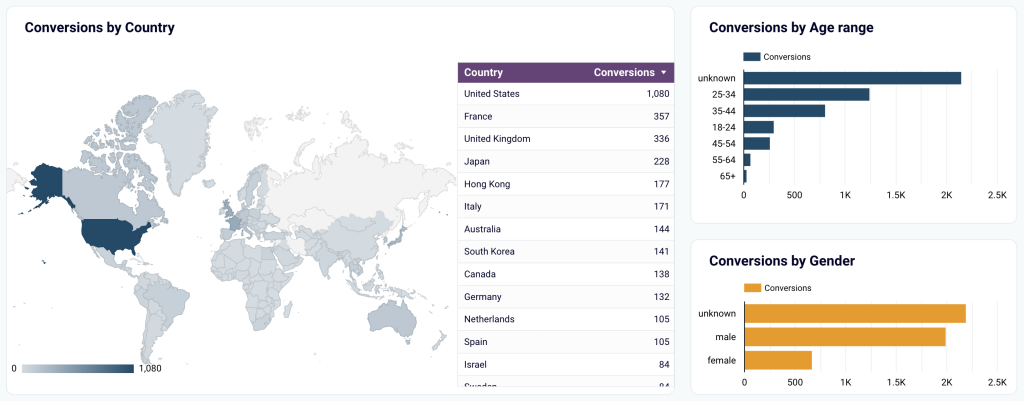
Use it to analyze campaign conversions filtered by country, age range, or gender to identify the best-performing demographics.
6. Experiment with geotargeting
Analyze the conversion rate you get from customers in different locations. You will see that some areas perform better than others – that’s a chance for you to adjust your bidding strategy and improve your campaign results.
There’s no single recipe for what to do here, so you will need to experiment with geotargeting and see what works best for you. The general principle would be to increase your bid for the best-performing geographical areas.
As an alternative, you can run multiple campaigns, each tailored for a specific geo-segment that it’s targeting. This gives you more flexibility with ad copy – you can use more personalized CTAs or adjust your offerings to different locations’ specifics. All in all, it can significantly improve performance and optimize your Google Ads budget.
7. Match the search intent
Every keyword has an intent behind it — something the user wants to find on Google.
Some keywords are pretty straightforward, like “buy dishwasher Tampa, FL.” This user clearly wants to make a purchase and do it in a specific location.
Others may have more than one search intent. For instance, people entering the keyword “Google Ads” in the search bar may want to learn what Google Ads are, find basic information about running Google Ads, or get to the Google Ads website.
To optimize your ads’ CTR rate, you must tailor the ad copy to the search intent behind the keyword. The best way to do this effectively is to make several educated guesses about what people with this intent want to see and A/B test your ads.
If you’re using broad-match keywords, it’s impossible to cover all possible search intents. Focus on the type of intent your target audience would have. This way, you save money on clicks and increase the conversion rate.
8. Make use of ad extensions
Google Ads campaign optimization improves two things: who sees your ads and what exactly they see. Writing a good, A/B-tested copy is one part of what users see. Google also lets you add ad extensions to give users more conversion options. This is very important for optimizing Google search ads, so you should consider this option. You can add:
- Call button
- Download app button
- Pricing
- Promotions
- Images
- Business hours & location
- Lead forms
- Structured snippets
- Navigational site links
- Sitelinks
- Callouts
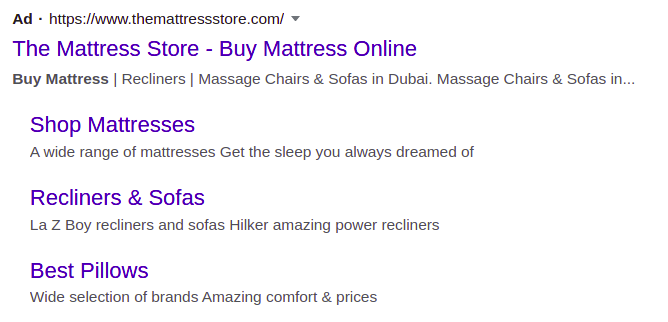
All of these may improve CTR or conversion rate. Experiment with adding different assets to see which performs better across campaigns.
9. Focus on what performs best
The main idea behind Google Ads campaign optimization is attracting more leads for less ad spend. One major way to do this is to cut down spending on campaigns that don’t perform well and focus your efforts and spending on those that excel.
You can also optimize your worst-performing ads, but it’s better to focus on your best performers. Since these ad campaigns currently provide the least benefit, you can increase it with a bit of optimization.
While doing that, you can limit your spending on other campaigns by limiting the daily spending or introducing bid adjustments.
Bid adjustments are the percentage change in your bids that you can configure to increase or decrease depending on the type of keyword, time of day, location of the user, and plenty of other factors.
To track the best-performing campaigns, use the already mentioned Coupler.io’s Google Ads dashboard in Looker Studio.
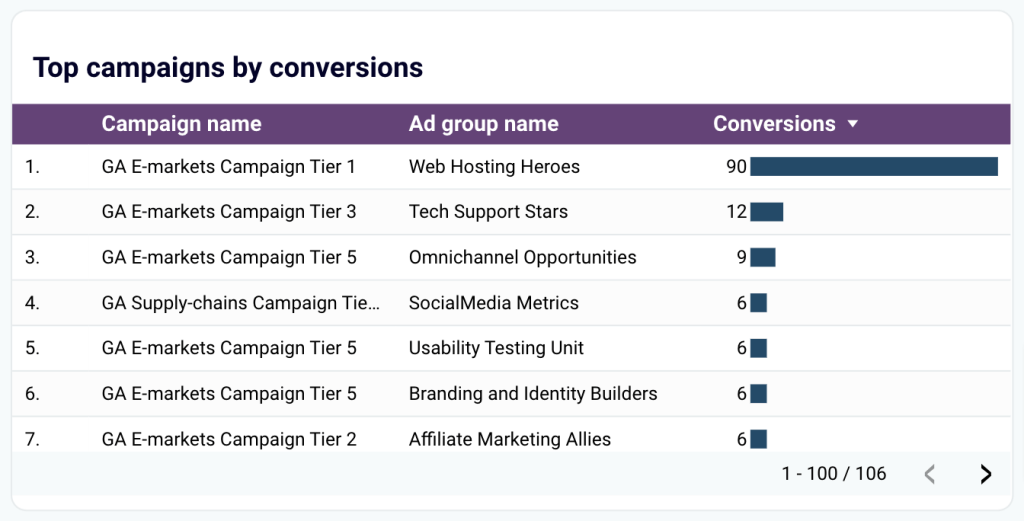
It quickly answers the question of which campaigns and, accordingly, ad groups result in most conversions.
10. Optimize the dayparting settings
It’s essential to display your ads when they make the most sense. This means your campaign settings should match your customers’ lifestyles and consider how your product/service is used.
For example, you want to promote a special offer for business lunches with free delivery to the office. Then, it makes sense to be more active on business days around lunchtime or in the morning. This is when your target audience needs your product the most and will be searching for it. At the same time, the demand is likely to be lower in the evening and on weekends. You can use such insights to optimize your bidding strategy and get the best results.
11. Leverage remarketing
If someone has already expressed interest in your product or service, it’s worth giving them a bit more attention. Maybe they just need a reminder or an extra push to become your customers. So, it’s highly recommended to try running remarketing campaigns targeted at people who have already visited your landing page or even added some items to the cart but abandoned it.
One of the powerful instruments for doing so is using RLSA, or remarketing lists, for search ads. This allows you to reach people who searched for relevant products or services on Google, saw your ad, and ended up on your website. It’s an excellent opportunity to talk to an audience already interested in what you have to offer. You can better tailor your messaging and address their pain points.
12. Conduct cross-channel analysis
The last tip on our list is to look at the bigger picture and see how your campaigns perform on different PPC channels. For example, you might find out that a specific campaign has a less-than-stellar performance on Google Ads but yields great results on another platform. In this case, it makes sense to redistribute your budget between the channels accordingly.
To get that kind of insight, you need a cockpit to see everything happening across all your PPC channels. This can be done with Coupler.io’s ads overview dashboard template in Looker Studio. It includes metrics from multiple ad platforms: Google Ads, LinkedIn Ads, Meta Ads (Facebook/Instagram), and more. For example, it helps you determine how each platform performs by comparing metrics such as click-through rates and impressions.

You can also assess which campaigns across platforms deliver the best ROI by comparing their performance side by side.
If you only need to compare campaign performance between Google Ads and Meta Ads, use Coupler.io’s Google Ads vs. Meta Ads dashboard template in Looker Studio. For instance, it provides essential metrics to help you determine which platform offers better value for your investment.

This dashboard also tracks your expenditure trends, showing how much you spent on each platform over a specified period.

There’s more to explore – check out Coupler.io’s gallery of Google Ads dashboard templates to find one that suits your needs.
How to optimize Google Ads for conversions – a summary
Of course, an easy way to get more conversions would be to simply increase your ad budget. However, few companies would be happy to have high conversions at any cost. Ideally, the profit you receive from the ads should be greater than the campaign cost – otherwise, your campaign won’t be profitable. Optimizing Google Ads for conversions is a long process that involves running experiments and carefully making adjustments until you get the desired outcome.
At the beginning of this article, we already provided a useful Google Ads optimization checklist. Together with the 12 tips from the section above, it gives you an actionable overview of the steps you can take to optimize Google Ads for conversions.
As we’ve covered a lot of information, let’s make a short summary of the ways to boost ad performance while using your budget wisely:
- Revise, edit, and A/B test your ad copy
- Review your bidding strategy and try different options
- Check the quality score of your keywords
- Use the search terms report for insights
- Update your keyword lists
- Update ad group structure and account structure
- Check the conversion tracking settings
- Refresh your landing pages
- Redistribute your budget in favor of best-performing keywords
- Constantly keep track of the key metrics and analyze them
- Leverage automated reporting to help you
- Conduct Google Ads competitor analysis
- Experiment with geotargeting and dayparting settings
- Use extensions for Google search ad optimization
- Conduct remarketing campaigns
- Perform cross-channel analysis
Following these steps, you can run experiments and uncover the right combination of settings, keywords, bidding strategies, and messages that perform best for your specific case. Once you understand what works best, make sure most of your budget goes to high-performers. After this… repeat the optimization process to refine your strategy further.
Don’t forget to check out the top PPC trends in 2025 to stay up-to-date with the latest industry changes.
Now you know how to optimize Google Ads!
In this article, we’ve talked a lot about different techniques that can help you optimize Google Ads. Implementing these best practices and using our checklist will improve your campaign results in the long run. As you already know, Google Ads optimization is more than a one-and-done task. Even if you are doing everything right, it could take some time before you start seeing significant changes and improvements. This is a long-term process with a cumulative effect.
This means you will need to get back to the optimization checklist from time to time and revise your strategy, bidding, copy, and keywords. When running your ads in a highly competitive niche, it is recommended that you regularly conduct a PPC audit.
If you want to ensure the best results, it’s also beneficial to automate reporting and monitor your Google Ads metrics in a live dashboard. This will help you always be in control, make quick adjustments, and continuously optimize Google Ads performance.
If you want to learn more about PPC reporting, see our guides on Google Ads metrics and PPC competitor analysis.

